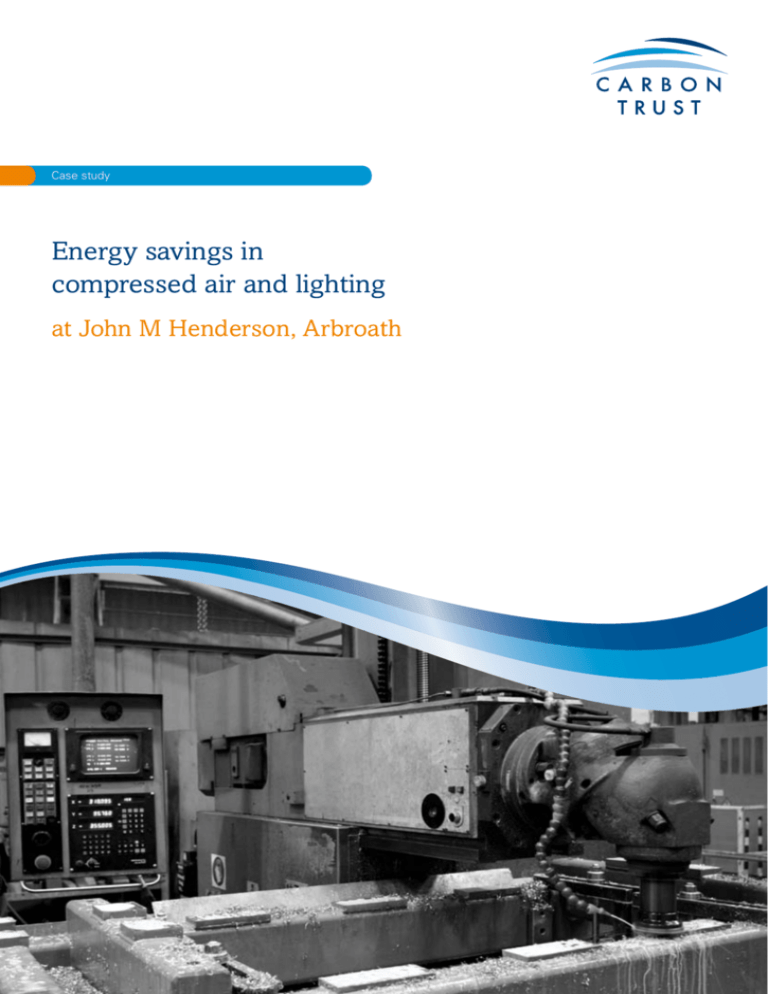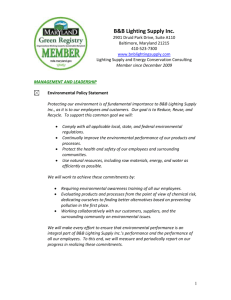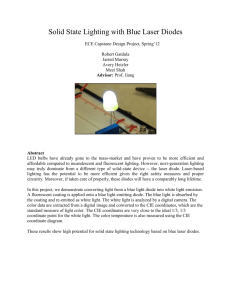
Case study
Energy savings in
compressed air and lighting
at John M Henderson, Arbroath
Case study
John M Henderson and Company Ltd
The business case
John M Henderson and
Company Ltd. is an
engineering company based
in Arbroath. The company
was highly commended for
their actions to save energy
at Carbon Trust Scotland’s
Energy Efficiency
in Manufacturing Industry
Awards in 2009.
The technical case
John M Henderson (JMH) has been established for over 140 years and specialises
in the design, manufacture and installation of mechanical handling equipment for
a range of industries in global markets. Other engineering commissions, such as
the construction of a prototype wave power generator, are also undertaken. JMH
employs about 90 people at its six acre site in Arbroath near Dundee. The site
comprises large workshops for fabrication and painting as well as office facilities for
design and management functions.
“The Carbon Trust has provided us with excellent advice and
guidance and without the financial assistance we would never have
been able to achieve such impressive savings. I have been fully
recommending the service to others.”
André Nell, finance manager at J M Henderson
Introduction
As part of an initiative to reduce costs and improve its competitive position, the
company decided to take steps to reduce energy consumption and identified
lighting and the generation of compressed air as areas that would provide significant
New Air Compressors
A single fixed speed compressor rated
at 75 kW provided all the compressed
air used in the factory. Managers at
John M Henderson suspected that the
compressor consumed large amounts
of energy and, as it was over 40 years
old, were concerned over its reliability.
They thus sought the help of an
equipment supplier to suggest more
efficient and reliable means of supplying
compressed air.
The supplier monitored compressed air
consumption and associated electricity
use over a week. This showed that
compressed air demand was generally
low, but increased significantly from time
to time when the factory’s shot blasting
unit was in use. The old compressor,
which was sized to meet the factory’s
savings. Working with equipment suppliers, managers developed investment
maximum level of air demand, was
thus oversized for the normal low level
of air consumption and this resulted
in it running offload for long periods consuming energy without generating
any compressed air.
Using the information collected through
the monitoring period, the supplier was
able to propose the replacement of the
existing large compressor with two
smaller units rated at 37 kW each (one
compressor could run at varying speeds
and the other was a fixed speed unit).
Together these compressors are able to
closely match the factory’s air demands
at all times without wasting energy.
The variable speed compressor acts as
the main duty unit and is able to meet
fluctuations in the factory’s normal air
consumption.
When the shot blast unit is in use the
air demand increases and the fixed
speed compressor automatically starts
to meet the higher demand, whilst
the variable speed unit continues to
modulate in response to variations in
factory air demand. This configuration
avoids the need for compressors
wastefully running offload at any time.
By replacing a single large compressor
with two smaller units to closely match
the factory’s demand for compressed
air, JMH will save almost 220 MWh
per year and will reduce emissions
of carbon dioxide by 118 tonnes per
year. Also, the company now has
standby capacity for the provision of
compressed air and so can continue
most factory operations even if a
compressor breaks down.
proposals for two energy saving projects which were approved by the board and
then implemented.
Lighting
The company was highly commended by Carbon Trust Scotland at the 2009 Energy
Lighting in the JMH office block was
provided by ceiling mounted fluorescent
lamps which used older switch start
control gear*. On the advice of
equipment suppliers, the company
retrofitted new high frequency control
gear and modern efficient fluorescent
tubes into the existing light fittings.
Efficiency in Manufacturing Industry Awards for the reduction of energy use and
carbon emissions through the replacement of their air compressor and upgrades
to lighting.
Business benefits
Achievements
• Annual electricity savings of As a result of the energy saving projects, JMH has reduced its operating costs and
by reducing the company’s overall energy use, it is less exposed to high energy
over 270 MWh.
costs should prices rise in the future. The company obtained a Carbon Trust interest
• Total energy costs savings of
free loan to fund the projects and the cost savings realised through improved
almost £25,000/annum.
efficiency are sufficient to cover the cost of repaying the loan.
The overall payback period
for the projects is less than three years.
By installing new equipment maintenance costs have been reduced. The new
arrangements for compressed air supply provide backup capacity and so the risk
of unforeseen business interruptions due to breakdowns is significantly reduced.
• Carbon dioxide emission
Through its work on implementing the energy saving projects, JMH has developed
savings of approximately 147
its awareness of wider energy efficiency issues and these are now integrated into
tonnes/annum.
the management culture. It is continuing to pursue initiatives to reduce energy costs
and carbon emissions still further.
The new control gear provides
considerable energy savings compared
to switch start units and also reduces
replacement costs as lamp life is
extended.
High frequency control gear offers the
following benefits over switch start
units
- lower energy costs
- longer lamp life leading to reduced
replacement cost and disruption
- improved light quality by eliminating
flicker
Check whether you can make energy
savings by retrofitting your fluorescent
lighting with high frequency control
gear.
In the factory, the company replaced
the old sodium lighting with new lights
containing fluorescent lamps. The old
lights, which produced a yellow-orange
light, were mounted at the top of the
workshop bays and so the level of
lighting and quality achieved on the
workshop floor was quite poor. The new
lighting produces crisp white light and
is suspended at a lower height meaning
that illumination levels achieved at
the workshop floor are significantly
improved. In addition to reducing
energy use, the new lights help to
create a more productive and safer
working environment.
The changes to lighting implemented by
JMH will save approximately 53 MWh
per year and the associated saving in
carbon dioxide emissions is almost
29 tonnes per year.
*A ‘package’ of electrical or electronic
components including ballast, power factor
correction capacitor and starter that are
required to operate a fluorescent light.
Case study
The financial case
Investments, savings and payback
The cost for the installation of the two new compressors was £43,000 and the
energy savings provide cost savings of almost £20,000 per year at 2009 prices.
The payback period for this project is thus just over two years.
The project cost for the replacement lighting in the factory and the upgrades
to office lighting was £26,000. Energy cost savings achieved by the lighting
improvements are approximately £4,800 per year and so the overall payback period
is 5.4 years.
The Carbon Trust provided JMH with an interest free loan to pay for these energy
saving projects. JMH found the application process straightforward and the loan was
granted quickly, enabling the company to progress their plans without delay.
The combined payback period for the projects is less than the three years over which
the company is repaying the loan.
Expert advice
The Carbon Trust provides free expert energy
efficiency advice.
Energy surveys
Your company may qualify for a free energy
efficiency survey from one of the Carbon
Trust’s accredited consultants.
Energy efficiency loans
The Carbon Trust can provide an interest free
loan of up to £400,000, repayable over up to
four years for investment in energy efficiency
measures. The loans are available to Small
and Medium Enterprises or to businesses
that do not qualify for participation in the
Carbon Reduction Commitment.
For details of any of these services or
free publications, contact the Carbon Trust
Customer Care Centre on 0800 085 2005, or
visit the Carbon Trust website at
www.thecarbontrust.co.uk/energy/.
Free publications
CTV021 – Lighting technology overview
CTV017 – Compressed air technology
overview
CTG006 – Variable speed drives technology
guide
Tax incentives
The whole capital value of energy efficient
technologies, which qualify under the
Enhanced Capital Allowances scheme, may
be written down in the year of purchase. For
further information go to www.eca.gov.uk.
Further information
The Chartered Institution of Building Services
www.cibse.org
British Compressed Air Society
www.britishcompressedairsociety.co.uk
The Lighting Association
www.lightingassociation.com
The Carbon Trust is funded by the Department of Energy and Climate Change (DECC), the Department for Business, Enterprise
and Regulatory Reform (BERR), the Scottish Government, the Welsh Assembly Government and Invest Northern Ireland.
Whilst reasonable steps have been taken to ensure that the information contained within this publication is correct, the
authors, the Carbon Trust, its agents, contractors and sub-contractors give no warranty and make no representation as to its
accuracy and accept no liability for any errors or omissions. Any trademarks, service marks or logos used in this publication,
and copyright in it, are the property of the Carbon Trust. Nothing in this publication shall be construed as granting any licence
or right to use or reproduce any of the trademarks, service marks, logos, copyright or any proprietary information in any way
without the Carbon Trust’s prior written permission. The Carbon Trust enforces infringements of its intellectual property rights
to the full extent permitted by law.
The Carbon Trust is a company limited by guarantee and registered in England and Wales under Company number 4190230
with its Registered Office at: 6th Floor, 5 New Street Square, London EC4A 3BF.
Published in the UK: December 2009. Code number CTS166.
© The Carbon Trust 2009. All rights reserved
www.carbontrust.co.uk







